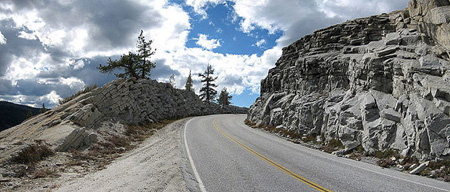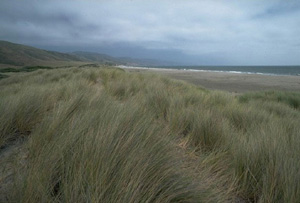Weathering Rates
Think of how many weathering processes like hydration, hydrolysis, and frost wedging are dependent on water in the environment.

Can you think of how climate might affect these weathering processes?
Different parts of the world have different climates. They also have different types and rates of weathering. For example, places with more rain have more chemical weathering because water is necessary to accomplish chemical weathering. Colder places have more physical weathering from frost-wedging.
While climate is the biggest determining factor in how fast and to what degree weathering takes place, several other factors also contribute to weathering rates. Click through the tabs to learn how each of these affect weathering rates.

Because climate determines temperature and the availability of water, weathering rates are greatly dependent on local climate conditions. The amount of rain that an area receives affects the degree to which these processes can take place. Warmer temperatures usually result in more of the chemical reactions involved in chemical weathering, as well as more biological activity. Thus, chemical weathering happens to the greatest degree in warm, humid climates, such as those near the equator. It is limited, however, in cold dry climates. Study the chart to see where different types of weathering peak in terms of annual rainfall and average temperature. Remember that 0°C is equal to 32°F.
|
| « Previous |
Next » |
|

The composition and structure of rocks also affect weathering rates. Limestone is particularly prone to weathering by carbonation, and silicate minerals are easily weathered by hydrolysis. Some rocks are just naturally more or less resistant to weathering than others. Also, rocks that are highly jointed are weathered more easily and more quickly because the joints are areas of weakness that break easily. Essentially, the more surface area that is exposed the more readily the rock weathers. Smaller particle sizes generally means more surface area exposed to the elements and thus lead to higher rates of weathering.
|
| « Previous |
Next » |
|

Vegetation affects weathering rates in various ways. Chemical weathering can be accelerated under dense vegetation because of increased acids from plants that react with rock and soil minerals. Plants can also accelerate physical weathering by root action. In other cases, vegetation can slow down physical weathering. For example, dense vegetative cover can protect rocks and soils from the effects of freeze-thaw cycles, or prevent exposure to heat and rain.
|
| « Previous |
Next » |
|

Several human activities can accelerate weathering rates. One of these is the production of air pollution that results in acid rain. Acid rain contains chemicals that eat away at rocks and soils, as well as weaken and break them down. Limestone rocks are especially prone to attack from acid rain.
|
| « Previous |
Next » |

Suppose you live in an area underlain by lots of limestone rocks. Use your knowledge of weathering to explain why the ground might be very uneven in your area.
Limestone is easily weathered away by carbonation, or the reaction of carbonic acid in the atmosphere with the minerals in the limestone. The uneven ground is indicative of the weathering away of limestone.

In what types of climate do you find thermal stress as a common type of weathering?
This kind of weathering is only found in environments that have a wide range in day and nighttime temperatures, such as a desert.
© KC Distance Learning. All rights reserved.



